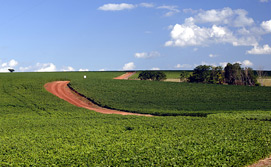View the video: click HERE
 |
 |
 |
 |
 |
Video transcript
My name is Waldir José
Mingotti. … I worked as an agronomist for 5 years. …
I used to see how beautiful a field of soy, corn and
wheat was. So I decided that I didn’t want only to
assist others, but also to cultivate those plants
myself. …
In the 1980s when I started farming, there was
already talk about no-till farming. … After adopting
it in the 1990s, … we solved problems with soil
preservation and erosion, and we managed to
introduce crop rotation. Then, we began to have weed
problems, because, with direct planting, we don’t
plow, which we did before to help eliminate the
weeds. …
For each kind of weed that competed with soy, we
needed a different herbicide. So you can imagine
having 10 weeds – and, for each kind, having to use
a different chemical group to control that weed. …
It was a nightmare. It became very hard to farm. ...
We saw transgenic soy as the solution – as the
factor that would make it possible to keep farming.
Otherwise, we would not be here. …
Where would we be? Certainly making the population
of our cities even bigger, because only a few would
have continued with agriculture and food production
in the way we did before. Thank God we have people,
scientists, who devote themselves … to introduce –
in a plant, in a crop, in a seed – a new gene that
makes it possible for us to believe and produce. ...
… I support that we pay for that and keep
encouraging scientists who are researching and
developing new technologies, … because even though
transgenic soy solved a problem for us, there may
come new problems in the future. We don't need only
transgenic soy. We need corn, wheat, oat, sorghum
and sunflower. …
Our consumers become more and more demanding on
quality, so we need to be more and more professional
to produce food. For us to be more professional and
more competitive and be able to have at least enough
profit to keep in business, it’s only possible with
biotechnology. …
… Before, we would spend 14-15 hours a day in the
fields checking and trying to control weeds. …
Nowadays, it’s possible to plan in advance for weed
and disease control. It’s amazing. With transgenic
soy, we just plant and never have to worry about
weeds. … This way, we have more time … to spend with
the ones we love.
Related Article
TRANSGENIC SOYBEAN CROPS DECREASE COSTS, INCREASE INCOME IN BRAZILIn 2006, farmers in Brazil were the third largest adopter of biotech crops globally – planting more than 28 million acres (11.5 million hectares) of transgenic soybean crops. A primary reasons for the broad adoption of the technology within Brazil has been the significant impact transgenic soybeans have had on farm income levels and the technology’s fit within no-till operations.
“We saw transgenic soy as the solution – as the factor that would make it possible to keep farming. Otherwise, we would not be here,” says Waldir José Mingotti, a husband and father of two, who farms 1,875 acres (750 hectares) with his brother in Tupanciretã.
After adopting no-till farming in the 1990s to solve problems with soil erosion, Mingotti notes that they had increased difficulty controlling weeds that previously would have been controlled by plowing. “For each kind of weed that competed with soy, we needed a different herbicide. So you can imagine having 10 weeds – and, for each kind, having to use a different chemical group to control that weed. … It was a nightmare. It became very hard to farm.”
With no-till farming, farmers leave the stubble or plant residue on the soil’s surface, rather than plowing or tilling it into the soil. The new crop is planted directly into this stubble, and growers must use herbicides to control weeds as they emerge and fight with the crop for nutrients and sunlight. Transgenic herbicide-tolerant soybeans make it simpler and most economical to control weeds in the crop with fewer herbicides on an as needed basis.
“Before, we would spend 14-15 hours a day in the fields checking and trying to control weeds,” Mingotti explains. “Nowadays, it’s possible to plan in advance for weed and disease control. It’s amazing. With transgenic soy, we just plant and never have to worry about weeds.”
Research conducted by Brookes and Barfoot indicates that the net savings on herbicide costs has been larger in Brazil than in other world areas due to the high average costs of weed control in Brazil. They report that the average cost savings from reduced herbicide use, fewer spray runs, labor and machinery – after accounting for the cost using the transgenic soybean technology – was between $35/ha and $88/ha in the period 2003-2005. Overall, the adoption of transgenic soybeans increased farm income levels in Brazil by $538 million in 2005. Cumulatively, over the period 1997 to 2005, farm incomes rose $1,367 million.
“… only a few would have continued with agriculture and food production in the way we did before. Thank God we have people, scientists, who devote themselves … to introduce – in a plant, in a crop, in a seed – a new gene that makes it possible for us to believe and produce,” says Mingotti. “I support that we pay for that and keep encouraging scientists who are researching and developing new technologies, … because even though transgenic soy solved a problem for us, there may come new problems in the future.”
© 2008 Monsanto Company. All rights reserved. The copyright holder consents to the use of this material and the images in the published context only and solely for the purpose of promoting the benefits of agricultural biotechnology.
